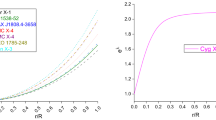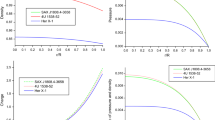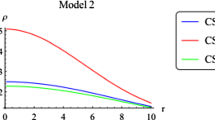Abstract
In this work, we examine a spherically symmetric compact body with isotropic pressure profile. In this context we obtain a new class of exact solutions of Einstein-Maxwell field equation for compact stars with uniform charged distributions on the basis of Pseudo-spheroidal space-time with a particular form of electric field intensity and the metric potential \(g_{11}\). Taking these two parameters into account further examination has been done to decide unknown constants and to depict several compact strange star candidates. By the isotropic Tolman-Oppenhimer-Volkoff(TOV) equation, we explore the equilibrium among hydrostatic, gravitational and electric forces. Then, we analyze the stability of the model through adiabatic index(\(\gamma \)) and velocity of sound (\(0<\frac{dp}{c^{2}d\rho }<1\)). We additionally talk about other physical features of this model e.g. pressure, redshift, density, energy conditions and mass-radius ratio of the stars in detail and demonstrated that our results satisfied all the basic prerequisites of a physically legitimate stellar model, showing density, pressure, pressure-density ratio, redshift and speed of sound are monotonically decreasing. The outcomes acquired are valuable in exploring the strength of other compact objects like white dwarfs, gravastars and neutron stars. Finally, we have shown that the obtained solutions are compatible with observational data for compact objects.







Similar content being viewed by others
References
Abubekerov, M.K., Antokhina, E.A., Cherepashchuk, A.M., Shimanskii, V.V.: Astron. Rep. 52, 379 (2008)
Alam, S., Ata, M., Baily, S., Beutler, F., Bizyaev, D., Blazek, J.A., et al.: (2016). arXiv:1607.03155
Andreasson, H.: J. Differ. Equ. 245, 2243–2266 (2008)
Betoule, M., Kessler, R., Guy, J., Mosher, J., Hardin, D., Biswas, R., et al.: Astron. Astrophys. 568, A22 (2014)
Bijalwan, N., Gupta, Y.K.: Astrophys. Space Sci. 334, 223–229 (2011a)
Bijalwan, N., Gupta, Y.K.: Astrophys. Space Sci. 334, 293–299 (2011b)
Bohmer, C.G., Harko, T.: Class. Quantum Gravity 23, 6479 (2006)
Bowers, R.L., Liang, E.P.T.: Astrophys. J. 188, 657 (1974)
Buchdahl, H.A.: Phys. Rev. D 116, 1027 (1959)
Canuto, V.: In: Solvay Conference on Astrophysics and Gravitation, Brussels (1973)
Delgaty, M.S.R., Lake, K.: Commun. Comput. Phys. 115, 395 (1998)
Demorest, P.B., Pennucci, T., Ransom, S.M., Roberts, M.S.E., Hessels, J.W.T.: Nature 467, 1081 (2010)
Elebert, P., et al.: Mon. Not. R. Astron. Soc. 395, 884 (2009)
Florides, P.S.: J. Phys. A, Math. Gen. 17, 14–19 (1983)
Gupta, Y.K., Kumar, M.: Gen. Relativ. Gravit. 37, 575–583 (2005)
Gupta, Y.K., Pratibha, K.J.: Astrophys. Space Sci. 333(1), 143–148 (2011)
Guver, T., Ozel, F., Cabrera- Lavers, A., Wroblewski, P.: Astrophys. J. 712, 964 (2010)
Harrison, B.K., et al.: Gravitational Theory and Gravitational Collapse. University of Chicago Press, Chicago (1965)
Heintzmann, H., Hillebrandt, W.: Astron. Astrophys. 38, 51 (1975)
Heydari-Fard, M., Razmi, H., Sepangi, H.R.: Phys. Rev. D 76(6), 066002 (2007)
Ivanov, B.V.: Phys. Rev. D 65, 104001 (2002)
Kippenhahn, R., Weigert, A.: Stellar Structure and Evolution. Springer, Berlin (1990)
Komathiraj, K., Maharaj, S.D.: Int. J. Mod. Phys. D 16, 1803 (2007)
Kumar, J., Gupta, Y.K.: Astrophys. Space Sci. 345, 331–337 (2013)
Kumar, J., Gupta, Y.K.: Astrophys. Space Sci. 351, 243–250 (2014)
Kumar, J., et al.: (2018a). arXiv:1804.01779 [gr-qc]
Kumar, J., Prasad, A.K., Maurya, S.K., Banerjee, A.: Eur. Phys. J. C 78, 540 (2018b)
Landau, L.D., Lifshitz, E.M.: The Classical Theory of Fields, vol. 2. Elsevier, Amsterdam (2013)
Leeuwen, J.V. (ed.): Structure of quark stars, no. 291 in Neutron Stars and Pulsars: Challenges and Opportunities after 80 Years, Proceedings IAU Symposium (2012)
Malheiro, M., Picanco, R., Ray, S., Lemos, J.P.S., Zanchin, V.T.: Int. J. Mod. Phys. D 13, 1375 (2004)
Negreiros, R.P., Weber, F., Malheiro, M., Usov, V.V.: Phys. Rev. D 80, 083006 (2009)
Negreiros, R.P., Mishustin, I.M., Schramm, S., Weber, F.: Phys. Rev. D 82, 103010 (2010)
Oppenheimer, J.R., Volkoff, G.M.: Phys. Rev. 55, 374 (1939)
Pant, N., Mehta, R.N., Pant, J.M.: Astrophys. Space Sci. 330(2), 353–359 (2010)
Patel, L.K., Kopper, S.S.: Aust. J. Phys. 40(3), 441–448 (1987)
Rawls, M.L., Orosz, J.A., Mcclintock, J.E., Torres, M.A.P., Bailyn, C.D., Buxton, M.M.: Astrophys. J. 730, 25 (2011)
Ray, S., Espindola, A.L., Malheiro, M., Lemos, J.P.S., Zanchin, V.T.: Phys. Rev. D 68, 084004 (2003)
Ruderman, R.: Annu. Rev. Astron. Astrophys. 10, 427 (1972)
Schwarzschild, K.: Sitzer. Preuss. Akad. Wiss. Berlin 424, 189 (1916)
Sharma, R., Mukherjee, S., Maharaj, S.D.: Gen. Relativ. Gravit. 33, 999 (2001)
Sokolov, A.I.: JETP Lett. 79, 1137 (1980)
Straumann, N.: General Relativity and Relativistic Astrophysics, vol. 43. Springer, Berlin (1984)
Tolman, R.C.: Phys. Rev. 55, 364 (1939)
Usov, V.V.: Phys. Rev. D 70, 067301 (2004)
Usov, V.V., Harko, T., Cheng, K.S.: Astrophys. J. 620, 915 (2005)
Varela, V., Rahaman, F., Ray, S., Chakraborty, K., Kalam, M.: Phys. Rev. D 82, 044052 (2010)
Weber, F., Meixner, M., Negreiros, R.P., Malheiro, M.: Int. J. Mod. Phys. E 16, 1165 (2007)
Weber, F., Negreiros, R., Rosenfield, P.: Neutron Stars and Pulsars. Astrophysics and Space Science Library Berlin, p. 357. Springer, Berlin (2009)
Weber, F., Hamil, O., Mimura, K., Negreiros, R.P.: Int. J. Mod. Phys. D 19, 1427 (2010)
White, M., Scott, D., Silk, J.: Annu. Rev. Astron. Astrophys. 32, 319–370 (1994)
Zeldovich, Ya.B., Novikov, I.D.: Relativistic Astrophysics Vol. 1. Stars and Relativity. University of Chicago Press, Chicago (1971)
Zhang, Y., Zhou, Y., Li, G.-P.: Int. J. Theor. Phys. 53(1), 216–223 (2014)
Author information
Authors and Affiliations
Corresponding author
Additional information
Publisher’s Note
Springer Nature remains neutral with regard to jurisdictional claims in published maps and institutional affiliations.
Appendix
Appendix
The expression for coefficients used in Eq. (17)
Rights and permissions
About this article
Cite this article
Prasad, A.K., Kumar, J. Charged analogues of isotropic compact stars model with buchdahl metric in general relativity. Astrophys Space Sci 366, 26 (2021). https://doi.org/10.1007/s10509-021-03931-9
Received:
Accepted:
Published:
DOI: https://doi.org/10.1007/s10509-021-03931-9




